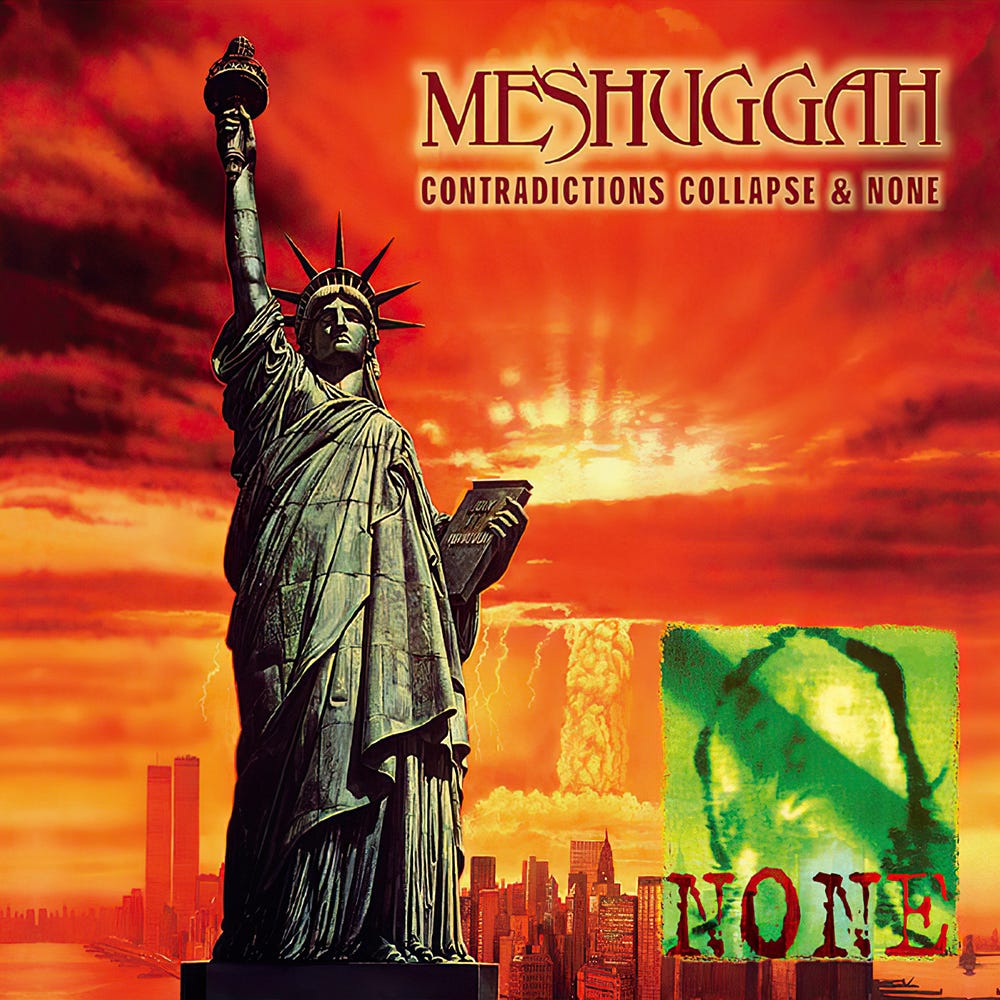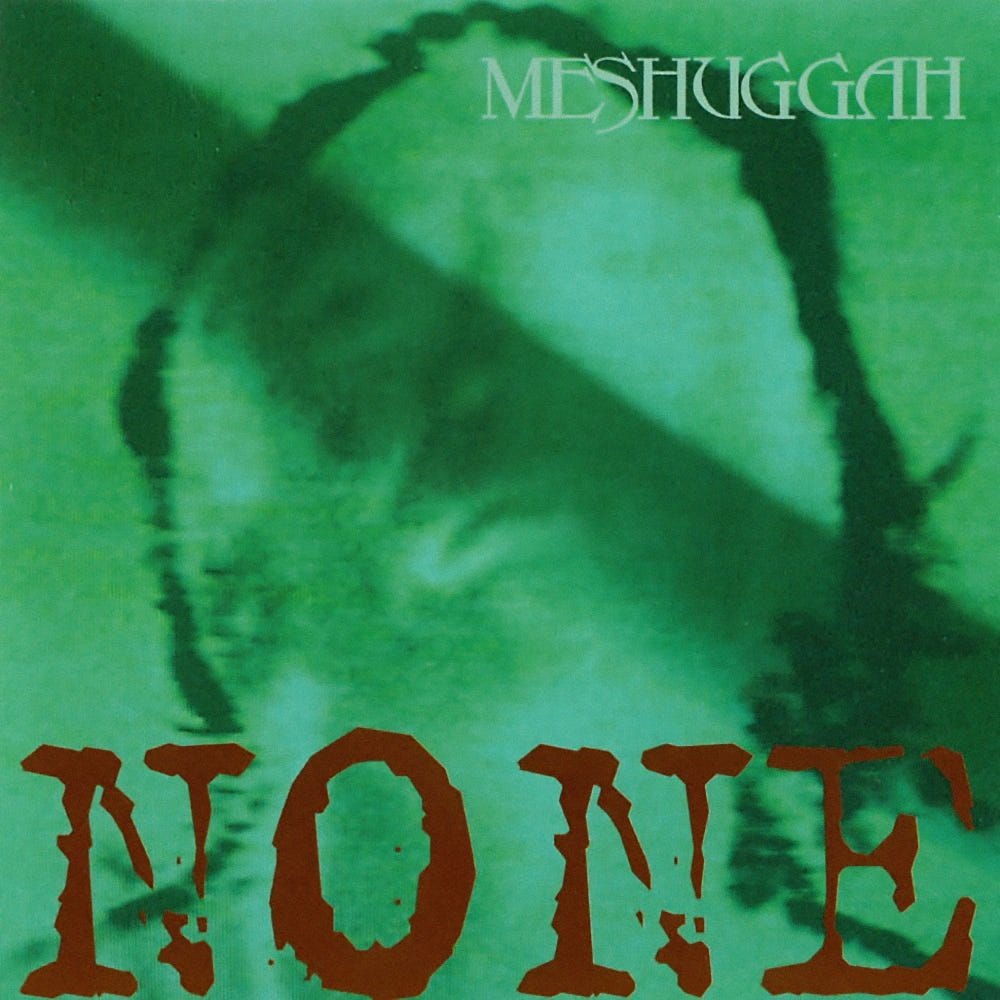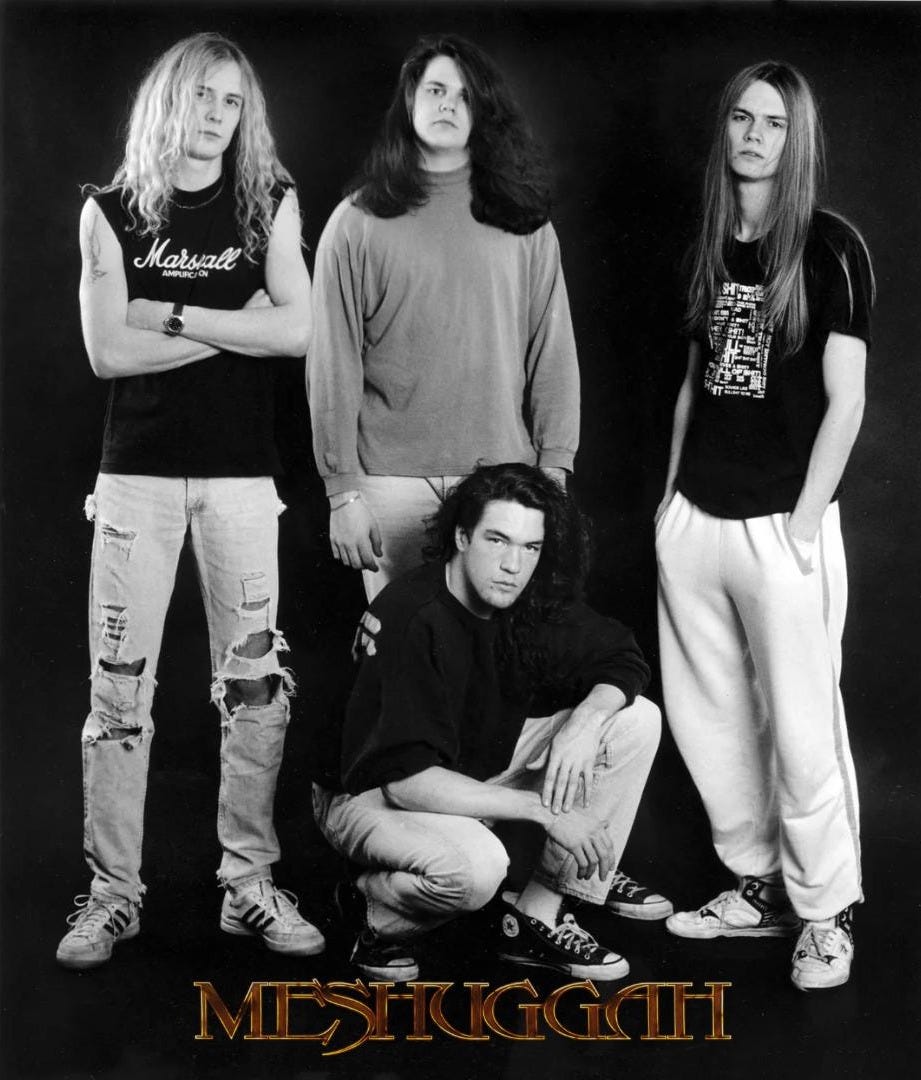Meshuggah | Contradictions Collapse (Nuclear Blast)
Born of Legends
Before the universe of metal knew Meshuggah as the cold architects of polyrhythmic chaos, before “djent” became a word whispered in reverent awe or seething disdain, there was a primal eruption in 1991. Contradictions Collapse was not so much a debut album as it was a statement of furious experimentation—a jagged, industrial metal machine crashing headlong into the tangled brambles of thrash, jazz-fusion, hip-hop rhythms, and existential anxiety.
It was the sound of young minds hammering philosophy into steel and screeching it through broken vocal cords. It was the beginning of Meshuggah’s mythos, raw and unrefined, bristling with tension—flawed, brilliant, and wholly untamed.
Formed in 1987 in Umeå, Sweden, Meshuggah began as something very different from what they would later become. The early lineup, originally under the name Metallien, saw guitarist Fredrik Thordendal as the band’s creative nucleus, a player deeply inspired by fusion wizard Allan Holdsworth and thrash legends like Metallica and Slayer. Jens Kidman, who would later become synonymous with Meshuggah’s vocal onslaught, initially played guitar but switched to vocals permanently as the band's lineup evolved.
By the time Contradictions Collapse was conceived, the lineup included
Jens Kidman Vocals, Rhythm Guitar
Fredrik Thordendal Lead Guitar, Backing Vocals, Co-Lead Vocals
Peter Nordin Bass
Niklas Lundgren Drums
This was the only Meshuggah album to feature Lundgren on drums—his intricate but human touch was soon replaced by Tomas Haake’s cybernetic pulse.
Signed by Nuclear Blast, the band released their debut full-length in May 1991. The album was produced by P.H. Rics and recorded at Tonteknik Recording in their hometown of Umeå—a studio that would later become legendary in Scandinavian underground metal circles.
Originally titled (All This Because Of) Greed, the record was steeped in lyrical explorations of systemic control, personal autonomy, societal decay, and the psychological erosion of the individual. While later Meshuggah albums would explore these themes through abstraction and mechanical transcendence, here they are tackled with more directness—occasionally clumsy, but always sincere.
Musically, Contradictions Collapse is a fascinating time capsule. It fuses thrash aggression with industrial precision, occasionally throwing in syncopated grooves that hint at the polyrhythmic complexity to come. The guitar tone is thick, almost downtuned beyond comprehension, and the drumming—still organic and not yet Haake’s polyrhythmic steam engine—delivers skittering hi-hats, triplet tom runs, and machine-gun snare bursts.
Its closest analogues are Voivod’s Nothingface, Prong’s Beg To Differ, and early Ministry, but even that sells short Meshuggah’s unique voice, already burrowing into fractured harmonic terrain and jarring rhythmic tangents.
Track-By-Track: Dissent In Twelve Movements
1. Paralyzing Ignorance (4:28)
The album opens with a mechanical crunch, a serrated thrash riff that would be at home on a late-’80s Metallica B-side. But then things twist: syncopated vocal phrasing, shifting drum accents, and sudden pauses erupt. Kidman spits venom, rage twisted by claustrophobic anxiety. Already, Meshuggah shows signs of abandoning traditional song structure.
2. Erroneous Manipulation (6:21)
A highlight for its eerie midsection and rhythmic modulations, this track contains lyrics reportedly written by Thordendal during his high school days—now lost to time. The song’s relentless cadence, counterpoint guitar harmonics, and whiplash tempo changes foreshadow the oblique violence of Destroy Erase Improve. A beautiful mess.
3. Abnegating Cecity (6:31)
The only track to receive a music video (now a relic of awkward black-and-white visual aggression), this one builds tension through palm-muted paranoia and progressive tempo shifts. The dual-vocal layering between Thordendal and Kidman adds disorientation, culminating in a spiraling descent that mirrors the lyrical themes of voluntary blindness.
4. Internal Evidence (7:27)
Here, the band’s fusion influences rear their head. Clean guitar passages weave into math-thrash syncopation, while the bass emerges prominently in a jazz-inflected interlude. The lyrics reference internal conflict, echoing early Voivod’s dystopian introspection.
5. Qualms Of Reality (7:10)
A philosophical centerpiece. The song grinds forward with oppressive force, balancing groove and speed. The breakdown mid-song sounds like factory pistons exploding out of sync, while the vocal cadence dips into proto-rap territory—highlighting the subtle influence of industrial and hip-hop on the band’s rhythm choices.
6. We'll Never See The Day (6:03)
A depressive dirge that plays with a semi-ballad structure before collapsing into thunder. The dynamics rise and fall like machinery struggling under pressure. It’s arguably the most emotional cut on the album, with lyrics hinting at nihilism and societal collapse.
7. Greed (7:06)
The album’s original title track and thematic anchor. Greed seethes with contempt for systemic exploitation. The riffs shift in metric structure, bending time signatures in rudimentary but effective ways. There’s an almost Voivodian use of dissonance, melding tension with groove.
8. Choirs Of Devastation (4:00)
A shorter, sharp burst of anger, more direct than most other tracks. The drums pound relentlessly as the guitars shred with chromatic aggression. Lyrically, it reads like a protest anthem wrapped in barbed wire.
9. Cadaverous Mastication (7:32)
This is actually a re-recording from their first EP (Meshuggah, 1989). It's more raw and thrashy, resembling early Testament or Dark Angel. The bass is notably gritty here, and the song lacks the refined schizophrenia of later compositions, but it’s a fascinating look at their thrash roots.
Bonus Tracks—From the None EP (1994)
10. Sickening (5:47)
Already, you can feel the tectonic shift. This track sees the emergence of Tomas Haake on drums and a more precise rhythmic approach. The mood is colder, more alien. It's a bridge between their early thrash leanings and the fully formed chaos of Destroy Erase Improve.
11. Gods Of Rapture (5:10)
This track introduces sharper polyrhythms and more controlled dynamics. It’s less wild, more cerebral—an evolution of the band's conceptual leanings. Vocals are processed and inhuman, a step toward the biomechanical Meshuggah of the future.
12. Aztec Two-Step (10:43)
The most abstract piece of the entire disc. Nearly jazz-metal in its scope, it features lengthy instrumental passages and odd-time breakdowns. The hidden track buried within the silence adds to the album’s mythic charm—a ghost in the machine.
Contradictions Collapse may not be the Meshuggah album that defined a genre, but it’s the one that predicted it. This is not the Meshuggah of obZen or Chaosphere—this is the sound of a band constructing their own language, using borrowed parts and broken rhythms to articulate a rage too complex for linear translation. This debut is chaotic, sprawling, imperfect, and absolutely vital. It is the primal scream before the machine took over.






